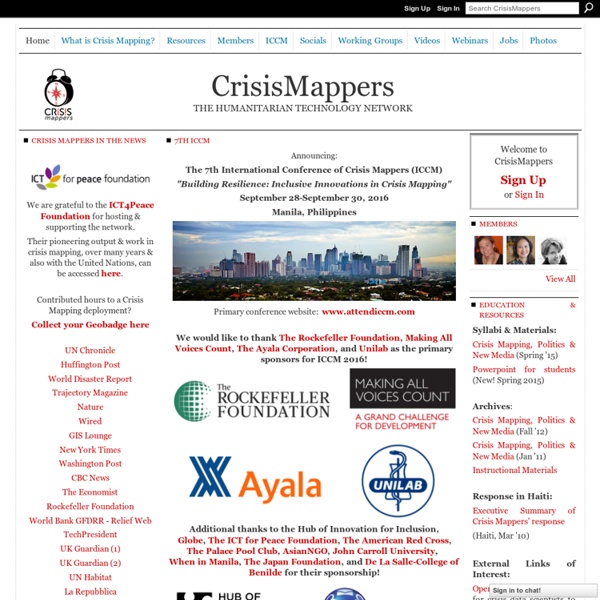



Course Materials - Crisis Mapping, Politics & New Media Dear community, I am developing a new course: Political Science 397: Crisis Mapping, Politics & New Media. As the course progresses I will post materials here for your review. Please feel free to use any portion of the materials posted here for your own course development. Follow us on twitter: #CMClass New Resources for the Fall 2011 Course: Grassroots mapping using kites and balloons on JCU’s campus Links to material from my Spring 2011 course: Information for instructors: visualization and analysis: Past Activities Open Street Maps Exercise What can we learn about maps & difficulties of making space/time maps from mapping our daily routine? Thanks for any input or comments! If you want to build a ship, don’t drum up people together to collect wood & assign them tasks & work, rather, teach them to long for the endless immensity of the sea. ~ Antoine de Saint-Exupéry ~ HT: @PatrickMeier Many thanks to the Department of Political Science at JCU for your encouragement, and your coffee.
Acerca de Nosotros The Sunlight Foundation is a national, nonpartisan, nonprofit organization that uses the tools of civic tech, open data, policy analysis and journalism to make our government and politics more accountable and transparent to all. Our vision is to use technology to enable more complete, equitable and effective democratic participation. Our overarching goal is to achieve changes in the law to require real-time, online transparency for all government information, with a special focus on the political money flow and who tries to influence government and how government responds. We believe that information is power, or, to put it more finely, disproportionate access to information is power. We approach our work in a number of ways. These efforts have produced real results. But we know that as government grows ever-more complex, and as the flow of political money becomes more perverse, we will all need better and more creative tools to ensure that democracy thrives.
ushahidi: Can anyone please help us... FR:Missing Maps Project Langues disponibles — Le Projet Missing Maps est un projet de cartographie humanitaire. Il s'agit d'un partenariat entre l'équipe humanitaire d'OpenStreetMap (Humanitarian OpenStreetMap Team, H.O.T.) et différentes organisations (les membres fondateurs, outre HOT, sont la Croix-Rouge américaine, la Croix-Rouge britannique, et Médecins sans frontières-UK). Site officiel (en Anglais) : missingmaps.org @themissingmaps MissingMapsProject Objectifs L'objectif principal est de cartographier les zones les plus vulnérables des pays en développement, afin que les acteurs et les ONG locales et internationales puissent utiliser les cartes et les données pour mieux répondre aux crises qui les touchent. Règles d'éthique L'utilisation d'OpenStreetMap garantit que la totalité des données réunie sous la bannière du projet Missing Maps restera libre, ouverte et utilisable selon les termes de la licence libre d'OpenStreetMap. Les membres du projet Missing Maps Niveau débutant Cartographes experts (geeks)
Geeks Without Bounds Ushahidi Acerca de «Net-Map Toolbox Watch Net-Map introduction video: evaschiffer_netmaps_ifpri <p>JavaScript required to play <a hreflang="en" type="video/mp4" href=" Listen to podcast (0 min 22 sec – click player below) Net-Map is an interview-based mapping tool that helps people understand, visualize, discuss, and improve situations in which many different actors influence outcomes (Net-Map Brochure: 679 KB). what actors are involved in a given network,how they are linked,how influential they are, andwhat their goals are. Determining linkages, levels of influence, and goals allows users to be more strategic about how they act in these complex situations. The tool is low-tech and low-cost and can be used when working with rural community members with low formal education as well as with policy makers or international development actors. Equipment needed: 1.Preparation: Define question (e.g. 2.Actor selection: 3.Drawing of links:
Patrick Meier (patrickmeier) OSM Tasking Manager -